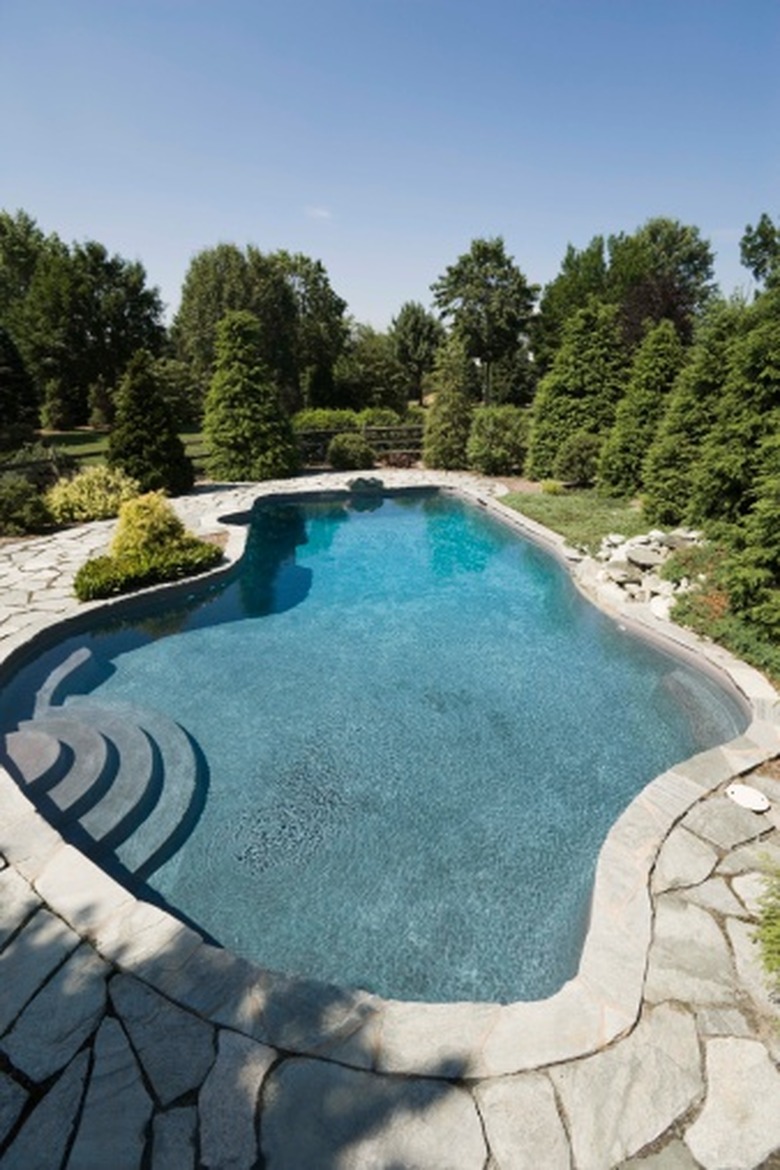How To Control Water Hardness In Swimming Pools
Things Needed
- Water hardness test strips or a pool testing kit that tests water hardness
- Calcium chloride (CaCl) to increase water hardness
- Water softener to decrease water hardness
Tip
Test water hardness once per week when the pool is in active use, and once per month when there is water in the pool but you aren't using it. This will let you monitor the hardness of the water before hardness variations can cause problems with pumps or other pool components.
Warning
Calcium chloride can irritate the eyes, skin, and throat. Use caution when handling calcium chloride or adding it to your pool so that it doesn't come in contact with your eyes, mouth, or skin. Don't add more than 10 pounds of calcium chloride per 10,000 gallons of pool water at one time. If you think your pool requires more than this, add this amount and then test the water hardness again after 24 hours. Adding too much calcium chloride can result in water becoming too hard or particles not dissolving in the water properly.
Maintaining proper water hardness in a swimming pool is an important task. Hard water clogs pipes and pumps with deposits, making the water cloudy and creating a scale on the pool filter. Water that isn't hard enough will damage metal, concrete and tile in the pool by dissolving the minerals they contain. You should test your water regularly with a pool tester that contains hard water test strips to monitor the total hardness of the water. Water hardness below 200 ppm is too soft for pool water. Hardness above 400 ppm is too hard.
High Water Hardness
Step 1
Drain water from the pool. There aren't any chemicals that can be added to pool water to reduce its hardness, so the only way to lower water hardness is to remove some of the water and replace it with water that is softer. If the water hardness is between 400 and 500 ppm you should drain half of the water from the pool; if it is over 500 ppm you should drain 2/3 or more of the water. If the pool has developed scale deposits due to the high water hardness, drain all of the water and clean the pool liner before refilling.
- Maintaining proper water hardness in a swimming pool is an important task.
- If the pool has developed scale deposits due to the high water hardness, drain all of the water and clean the pool liner before refilling.
Step 2
Test the hardness of the water you'll add to the pool before you start refilling. To reduce the water hardness of the pool water your source needs to have softer water; if it's too high then you won't see a significant reduction. Hook a water softener up to your water source if necessary to reduce the hardness of the water. The average of the hardness levels of your existing pool water and the new water should fall between 200 and 400 ppm.
Step 3
Refill the pool using the softer water. Allow it to mix and settle for at least 24 hours. Retest the water hardness of the pool once sufficient time has passed. If the pool water still has a hardness over 400 ppm, repeat the draining and refilling and test again after 24 hours.
- Test the hardness of the water you'll add to the pool before you start refilling.
- To reduce the water hardness of the pool water your source needs to have softer water; if it's too high then you won't see a significant reduction.
Low Water Hardness
Step 1
Determine how much calcium chloride solution needs to be added to your pool water to increase the water hardness and bring it within the optimal hardness range. Consult the packaging or usage instructions to see how much calcium chloride should be added to your pool based on the number of gallons of water your pool holds.
Step 2
Mix the calcium chloride with water, stirring gently to ensure that it dissolves completely. Pour the calcium chloride solution into your pool water. Once all of the solution has been added to the water, brush the bottom of the pool to agitate the water and to aid in the dissolving of any undissolved particles that settled to the bottom of the pool.
Step 3
Allow the water to mix and settle for at least 24 hours. Test the hardness of your pool water again after the time has passed. If the water is still too soft, mix and add more calcium chloride to increase the water hardness further. Wait 24 hours before testing again.
- Determine how much calcium chloride solution needs to be added to your pool water to increase the water hardness and bring it within the optimal hardness range.
